M100 Band3 SingleDish 4.3: Difference between revisions
| Line 95: | Line 95: | ||
The raw data have been provided to you in the ASDM (ALMA Science Data Model). | The raw data have been provided to you in the ASDM (ALMA Science Data Model). | ||
It is the native format of the data produced by the observatory but cannot be processed by CASA. | It is the native format of the data produced by the observatory but cannot be processed by CASA. | ||
The conversion from ASDM to MS is done | The conversion from ASDM to MS is done with the task {{importasdm}}. | ||
<source lang="python"> | <source lang="python"> | ||
Revision as of 09:18, 13 March 2015
This page is currently under construction.
DO NOT USE IT.
To navigate the CASAguides pages, visit [http://casaguides.nrao.edu/ casaguides.nrao.edu ]
M100 Single Dish Data Reduction (under modification)
- This guide requires CASA 4.3 and assumes that you have downloaded M100_Band3_SD_UncalibratedData.tgz from M100_Band3#Obtaining_the_Data
- Details of the ALMA observations are provided at M100_Band3
- This portion of the guide covers calibration of the raw visibility data. To skip to the imaging portion of the guide, see: M100_Band3_Combine_4.3.
Overview
This portion of CASA Guide will cover the data reduction of the Total Power (TP) array observations of M100. The data consist of the following two groups of datasets: "amplitude calibrator" and "science". Their targets are the quasar 3C279 and the science target M100, respectively. The data are reduced in the following steps:
- Both the amplitude calibrator and science datasets are calibrated into units of Kelvins.
- The amplitude calibrator data are used for deriving the Jansky/Kelvin (Jy/K) factors for individual days and frequencies (spectral windows) using radio continuum emission of the source.
- Using the derived Jy/K values, the science data are calibrated into Jy/beam units.
- The calibrated science data are imaged into a data cube.
The combination of the resultant image with the interferometric (12-m array and 7-m array) data is explained in a separate page, M100_Band3_Combine_4.3.
This guide is designed for CASA 4.3.0.
Confirm your version of CASA
This guide has been written for CASA release 4.3.0. Please confirm your version before proceeding.
# In CASA
version = casadef.casa_version
print "You are using " + version
if (version < '4.3.0'):
print "YOUR VERSION OF CASA IS TOO OLD FOR THIS GUIDE."
print "PLEASE UPDATE IT BEFORE PROCEEDING."
else:
print "Your version of CASA is appropriate for this guide."
Summary of Datasets
The observations were made on the 1st, 5th, 7th, and 17th July 2014, using two or three 12-m antennas and the ACA correlator. The table below indicates the ID's of the Execution Blocks, their start and end times, and the antennas in the array. There are four amplitude calibrator datasets (i.e., one per day) and nine science datasets (i.e., two or three per day).
#Amplitude Calibrator uid___A002_X85c183_X895 Observed from 2014-07-01T23:35:23.1 to 2014-07-02T00:07:54.6 (UTC) DA61, PM03, PM04 uid___A002_X8602fa_Xc3 Observed from 2014-07-05T23:21:25.6 to 2014-07-05T23:53:41.0 (UTC) PM02, PM03, PM04 uid___A002_X864236_Xe1 Observed from 2014-07-07T22:27:35.4 to 2014-07-07T23:01:05.7 (UTC) PM03, PM04 uid___A002_X86fcfa_X3ae Observed from 2014-07-17T21:48:30.0 to 2014-07-17T22:20:52.2 (UTC) DV10, PM03, PM04 #Science uid___A002_X85c183_X36f Observed from 2014-07-01T21:51:26.2 to 2014-07-01T22:40:28.4 (UTC) DA61, PM03, PM04 uid___A002_X85c183_X60b Observed from 2014-07-01T22:43:50.0 to 2014-07-01T23:32:39.6 (UTC) DA61, PM03, PM04 uid___A002_X8602fa_X2ab Observed from 2014-07-05T23:58:03.6 to 2014-07-06T00:46:52.0 (UTC) PM02, PM03, PM04 uid___A002_X8602fa_X577 Observed from 2014-07-06T00:55:17.8 to 2014-07-06T01:44:07.3 (UTC) PM02, PM03, PM04 uid___A002_X864236_X2d4 Observed from 2014-07-07T23:03:48.1 to 2014-07-07T23:53:47.9 (UTC) PM03, PM04 uid___A002_X864236_X693 Observed from 2014-07-07T23:56:09.6 to 2014-07-08T00:46:07.1 (UTC) PM03, PM04 uid___A002_X86fcfa_Xd9 Observed from 2014-07-17T20:55:15.5 to 2014-07-17T21:44:06.1 (UTC) DV10, PM03, PM04 uid___A002_X86fcfa_X664 Observed from 2014-07-17T22:24:17.3 to 2014-07-17T23:13:08.0 (UTC) DV10, PM03, PM04 uid___A002_X86fcfa_X96c Observed from 2014-07-17T23:23:37.0 to 2014-07-18T00:12:25.3 (UTC) DV10, PM03, PM04
Calibration into Brightness Temperature in Kelvins
In this section, the data are calibrated into brightness temperature in units of K.
Here we define the lists of the Execution Block ID's of the amplitude calibrator and science datasets, in order to facilitate data reduction using for-loops.
# In CASA
basename_ampcal = ['uid___A002_X85c183_X895', 'uid___A002_X8602fa_Xc3',
'uid___A002_X864236_Xe1', 'uid___A002_X86fcfa_X3ae']
basename_science = ['uid___A002_X85c183_X36f', 'uid___A002_X85c183_X60b',
'uid___A002_X8602fa_X2ab', 'uid___A002_X8602fa_X577',
'uid___A002_X864236_X2d4', 'uid___A002_X864236_X693',
'uid___A002_X86fcfa_Xd9', 'uid___A002_X86fcfa_X664',
'uid___A002_X86fcfa_X96c']
Create Measurement Sets
The first thing to do is to convert the dataset into the CASA Measurement Set (MS) format. The raw data have been provided to you in the ASDM (ALMA Science Data Model). It is the native format of the data produced by the observatory but cannot be processed by CASA. The conversion from ASDM to MS is done with the task importasdm.
# In CASA
for name in basename_ampcal+basename_science:
importasdm(asdm=name,
vis=name+'.ms',
asis='Antenna Station Receiver Source CalAtmosphere CalWVR')
Now we have the converted datasets (with a suffix ".ms") and are ready to proceed.
The Analysis_Utilities package will be used for the following processes. Import the package and instantiate the stuffForScienceDataReduction class therein.
# In CASA
import analysisUtils as aU
es = aU.stuffForScienceDataReduction()
This step is done by executing the reduction scripts named, e.g., uid___A002_X85c183_X36f.ms.scriptForSDCalibration.py, contained in the package (TBD). The execfile command is used for executing the script.
# In CASA
for name in basename_ampcal+basename_science:
execfile(name+'.ms.scriptForSDCalibration.py')
In the following, the contents of the reduction scripts are explained using a science dataset uid___A002_X85c183_X36f as an example.
Initial Inspection
The usual first step is then to get some basic information about the data. We do this using the task listobs, which will output a detailed summary of each dataset supplied.
# In CASA
listobs(vis='uid___A002_X85c183_X36f.ms',
listfile='uid___A002_X85c183_X36f.ms.listobs')
The output will be sent to the CASA logger, and also written in a file named uid___A002_X85c183_X36f.ms.listobs. You can print the contents of the file to the terminal by typing:
# In CASA
os.system('cat uid___A002_X85c183_X36f.ms.listobs')
Alternatively you can use your favorite pager (e.g., more, less) or editor (e.g., vi, emacs). CASA knows a few basic shell commands like 'cat', 'ls', and 'rm', but for more complex commands you may need to run them inside 'os.system("command")'. For more information see http://casa.nrao.edu/.
Here is an example of the (abridged) output from listobs for uid___A002_X85c183_X36f:
Observation: ALMA
Data records: 76314 Total elapsed time = 2942.21 seconds
Observed from 01-Jul-2014/21:51:26.2 to 01-Jul-2014/22:40:28.4 (UTC)
ObservationID = 0 ArrayID = 0
Date Timerange (UTC) Scan FldId FieldName nRows SpwIds Average Interval(s) ScanIntent
01-Jul-2014/21:51:26.2 - 21:53:29.5 1 0 J1215+1654 6087 [0,1,2,3,4,5,6,7,8] [1.15, 1.01, 1.01, 1.01, 1.01, 1.01, 1.01, 1.01, 1.01] [CALIBRATE_POINTING#ON_SOURCE,CALIBRATE_WVR#ON_SOURCE]
21:55:24.7 - 21:56:25.7 2 0 J1215+1654 6210 [0,9,10,11,12,13,14,15,16] [1.15, 0.48, 0.48, 0.48, 0.48, 0.48, 0.48, 0.48, 0.48] [CALIBRATE_SIDEBAND_RATIO#OFF_SOURCE,CALIBRATE_SIDEBAND_RATIO#ON_SOURCE,CALIBRATE_WVR#OFF_SOURCE,CALIBRATE_WVR#ON_SOURCE]
21:56:26.9 - 21:56:53.4 3 0 J1215+1654 1782 [0,9,10,11,12,13,14,15,16] [1.15, 0.48, 0.48, 0.48, 0.48, 0.48, 0.48, 0.48, 0.48] [CALIBRATE_ATMOSPHERE#OFF_SOURCE,CALIBRATE_ATMOSPHERE#ON_SOURCE,CALIBRATE_WVR#OFF_SOURCE,CALIBRATE_WVR#ON_SOURCE]
21:56:56.8 - 21:57:17.6 4 0 J1215+1654 582 [0,17,18,19,20,21,22,23,24] [1.15, 10.1, 1.01, 10.1, 1.01, 10.1, 1.01, 10.1, 1.01] [CALIBRATE_DELAY#ON_SOURCE,CALIBRATE_WVR#ON_SOURCE]
21:58:22.1 - 21:58:47.4 5 1 M100 1782 [0,9,10,11,12,13,14,15,16] [1.15, 0.48, 0.48, 0.48, 0.48, 0.48, 0.48, 0.48, 0.48] [CALIBRATE_ATMOSPHERE#OFF_SOURCE,CALIBRATE_ATMOSPHERE#ON_SOURCE,CALIBRATE_WVR#OFF_SOURCE,CALIBRATE_WVR#ON_SOURCE]
21:59:41.6 - 22:07:36.2 6 1 M100 12216 [0,17,18,19,20,21,22,23,24] [1.15, 1.01, 1.01, 1.01, 1.01, 1.01, 1.01, 1.01, 1.01] [CALIBRATE_WVR#OFF_SOURCE,CALIBRATE_WVR#ON_SOURCE,OBSERVE_TARGET#OFF_SOURCE,OBSERVE_TARGET#ON_SOURCE]
22:07:54.6 - 22:09:19.9 7 1 M100 2202 [0,17,18,19,20,21,22,23,24] [1.15, 1.01, 1.01, 1.01, 1.01, 1.01, 1.01, 1.01, 1.01] [CALIBRATE_WVR#OFF_SOURCE,CALIBRATE_WVR#ON_SOURCE,OBSERVE_TARGET#OFF_SOURCE,OBSERVE_TARGET#ON_SOURCE]
22:09:38.3 - 22:10:03.6 8 1 M100 1782 [0,9,10,11,12,13,14,15,16] [1.15, 0.48, 0.48, 0.48, 0.48, 0.48, 0.48, 0.48, 0.48] [CALIBRATE_ATMOSPHERE#OFF_SOURCE,CALIBRATE_ATMOSPHERE#ON_SOURCE,CALIBRATE_WVR#OFF_SOURCE,CALIBRATE_WVR#ON_SOURCE]
22:10:25.5 - 22:18:19.0 9 1 M100 12207 [0,17,18,19,20,21,22,23,24] [1.15, 1.01, 1.01, 1.01, 1.01, 1.01, 1.01, 1.01, 1.01] [CALIBRATE_WVR#OFF_SOURCE,CALIBRATE_WVR#ON_SOURCE,OBSERVE_TARGET#OFF_SOURCE,OBSERVE_TARGET#ON_SOURCE]
22:18:38.6 - 22:20:39.6 10 1 M100 3111 [0,17,18,19,20,21,22,23,24] [1.15, 1.01, 1.01, 1.01, 1.01, 1.01, 1.01, 1.01, 1.01] [CALIBRATE_WVR#OFF_SOURCE,CALIBRATE_WVR#ON_SOURCE,OBSERVE_TARGET#OFF_SOURCE,OBSERVE_TARGET#ON_SOURCE]
22:20:56.8 - 22:21:23.3 11 1 M100 1782 [0,9,10,11,12,13,14,15,16] [1.15, 0.48, 0.48, 0.48, 0.48, 0.48, 0.48, 0.48, 0.48] [CALIBRATE_ATMOSPHERE#OFF_SOURCE,CALIBRATE_ATMOSPHERE#ON_SOURCE,CALIBRATE_WVR#OFF_SOURCE,CALIBRATE_WVR#ON_SOURCE]
22:21:44.1 - 22:29:38.7 12 1 M100 12204 [0,17,18,19,20,21,22,23,24] [1.15, 1.01, 1.01, 1.01, 1.01, 1.01, 1.01, 1.01, 1.01] [CALIBRATE_WVR#OFF_SOURCE,CALIBRATE_WVR#ON_SOURCE,OBSERVE_TARGET#OFF_SOURCE,OBSERVE_TARGET#ON_SOURCE]
22:30:23.6 - 22:32:24.6 13 1 M100 3111 [0,17,18,19,20,21,22,23,24] [1.15, 1.01, 1.01, 1.01, 1.01, 1.01, 1.01, 1.01, 1.01] [CALIBRATE_WVR#OFF_SOURCE,CALIBRATE_WVR#ON_SOURCE,OBSERVE_TARGET#OFF_SOURCE,OBSERVE_TARGET#ON_SOURCE]
22:33:29.1 - 22:33:54.4 14 1 M100 1782 [0,9,10,11,12,13,14,15,16] [1.15, 0.48, 0.48, 0.48, 0.48, 0.48, 0.48, 0.48, 0.48] [CALIBRATE_ATMOSPHERE#OFF_SOURCE,CALIBRATE_ATMOSPHERE#ON_SOURCE,CALIBRATE_WVR#OFF_SOURCE,CALIBRATE_WVR#ON_SOURCE]
22:34:19.8 - 22:40:28.4 15 1 M100 9474 [0, 17, 18, 19, 20, 21, 22, 23, 24] [1.15, 1.01, 1.01, 1.01, 1.01, 1.01, 1.01, 1.01, 1.01] [CALIBRATE_WVR#OFF_SOURCE,CALIBRATE_WVR#ON_SOURCE,OBSERVE_TARGET#OFF_SOURCE,OBSERVE_TARGET#ON_SOURCE]
(nRows = Total number of rows per scan)
Fields: 2
ID Code Name RA Decl Epoch SrcId nRows
0 none J1215+1654 12:15:03.979140 +16.54.37.95680 J2000 0 14661
1 none M100 12:22:54.360000 +15.48.50.60000 J2000 1 61653
Spectral Windows: (25 unique spectral windows and 2 unique polarization setups)
SpwID Name #Chans Frame Ch0(MHz) ChanWid(kHz) TotBW(kHz) CtrFreq(MHz) BBC Num Corrs
0 WVR#NOMINAL 4 TOPO 184550.000 1500000.000 7500000.0 187550.0000 0 XX
1 ALMA_RB_03#BB_1#SW-01#FULL_RES 124 TOPO 91955.512 -15625.000 1937500.0 90994.5750 1 XX YY
2 ALMA_RB_03#BB_1#SW-01#CH_AVG 1 TOPO 90978.950 1734375.000 1734375.0 90978.9500 1 XX YY
3 ALMA_RB_03#BB_2#SW-01#FULL_RES 124 TOPO 93893.012 -15625.000 1937500.0 92932.0750 2 XX YY
4 ALMA_RB_03#BB_2#SW-01#CH_AVG 1 TOPO 92924.262 1937500.000 1937500.0 92924.2625 2 XX YY
5 ALMA_RB_03#BB_3#SW-01#FULL_RES 124 TOPO 102033.637 15625.000 1937500.0 102994.5750 3 XX YY
6 ALMA_RB_03#BB_3#SW-01#CH_AVG 1 TOPO 102986.762 1937500.000 1937500.0 102986.7625 3 XX YY
7 ALMA_RB_03#BB_4#SW-01#FULL_RES 124 TOPO 104033.637 15625.000 1937500.0 104994.5750 4 XX YY
8 ALMA_RB_03#BB_4#SW-01#CH_AVG 1 TOPO 104986.762 1937500.000 1937500.0 104986.7625 4 XX YY
9 ALMA_RB_03#BB_1#SW-01#FULL_RES 128 TOPO 101942.187 -15625.000 2000000.0 100950.0000 1 XX YY
10 ALMA_RB_03#BB_1#SW-01#CH_AVG 1 TOPO 100926.562 1781250.000 1781250.0 100926.5625 1 XX YY
11 ALMA_RB_03#BB_2#SW-01#FULL_RES 128 TOPO 103757.337 -15625.000 2000000.0 102765.1500 2 XX YY
12 ALMA_RB_03#BB_2#SW-01#CH_AVG 1 TOPO 102741.712 1781250.000 1781250.0 102741.7125 2 XX YY
13 ALMA_RB_03#BB_3#SW-01#FULL_RES 128 TOPO 111814.962 15625.000 2000000.0 112807.1500 3 XX YY
14 ALMA_RB_03#BB_3#SW-01#CH_AVG 1 TOPO 112783.712 1781250.000 1781250.0 112783.7125 3 XX YY
15 ALMA_RB_03#BB_4#SW-01#FULL_RES 128 TOPO 113689.962 15625.000 2000000.0 114682.1500 4 XX YY
16 ALMA_RB_03#BB_4#SW-01#CH_AVG 1 TOPO 114658.712 1781250.000 1781250.0 114658.7125 4 XX YY
17 ALMA_RB_03#BB_1#SW-01#FULL_RES 4080 TOPO 101945.850 -488.281 1992187.5 100950.0000 1 XX YY
18 ALMA_RB_03#BB_1#SW-01#CH_AVG 1 TOPO 100949.756 1992187.500 1992187.5 100949.7559 1 XX YY
19 ALMA_RB_03#BB_2#SW-01#FULL_RES 4080 TOPO 103761.000 -488.281 1992187.5 102765.1500 2 XX YY
20 ALMA_RB_03#BB_2#SW-01#CH_AVG 1 TOPO 102764.906 1992187.500 1992187.5 102764.9059 2 XX YY
21 ALMA_RB_03#BB_3#SW-01#FULL_RES 4080 TOPO 111811.300 488.281 1992187.5 112807.1500 3 XX YY
22 ALMA_RB_03#BB_3#SW-01#CH_AVG 1 TOPO 112806.906 1992187.500 1992187.5 112806.9059 3 XX YY
23 ALMA_RB_03#BB_4#SW-01#FULL_RES 4080 TOPO 113686.300 488.281 1992187.5 114682.1500 4 XX YY
24 ALMA_RB_03#BB_4#SW-01#CH_AVG 1 TOPO 114681.906 1992187.500 1992187.5 114681.9059 4 XX YY
Sources: 48
ID Name SpwId RestFreq(MHz) SysVel(km/s)
0 J1215+1654 0 - -
0 J1215+1654 25 - -
0 J1215+1654 26 - -
0 J1215+1654 27 - -
0 J1215+1654 1 - -
0 J1215+1654 2 - -
0 J1215+1654 3 - -
0 J1215+1654 4 - -
0 J1215+1654 5 - -
0 J1215+1654 6 - -
0 J1215+1654 7 - -
0 J1215+1654 8 - -
0 J1215+1654 9 - -
0 J1215+1654 10 - -
0 J1215+1654 11 - -
0 J1215+1654 12 - -
0 J1215+1654 13 - -
0 J1215+1654 14 - -
0 J1215+1654 15 - -
0 J1215+1654 16 - -
0 J1215+1654 17 100950 0
0 J1215+1654 18 100950 0
0 J1215+1654 19 102794.1 0
0 J1215+1654 20 102794.1 0
0 J1215+1654 21 112794.1 0
0 J1215+1654 22 112794.1 0
0 J1215+1654 23 114669.1 0
0 J1215+1654 24 114669.1 0
1 M100 0 - -
1 M100 25 - -
1 M100 26 - -
1 M100 27 - -
1 M100 9 - -
1 M100 10 - -
1 M100 11 - -
1 M100 12 - -
1 M100 13 - -
1 M100 14 - -
1 M100 15 - -
1 M100 16 - -
1 M100 17 100950 0
1 M100 18 100950 0
1 M100 19 102794.1 0
1 M100 20 102794.1 0
1 M100 21 112794.1 0
1 M100 22 112794.1 0
1 M100 23 114669.1 0
1 M100 24 114669.1 0
Antennas: 3:
ID Name Station Diam. Long. Lat. Offset from array center (m) ITRF Geocentric coordinates (m)
East North Elevation x y z
0 DA61 A075 12.0 m -067.45.17.9 -22.53.21.4 -4.5609 -499.7012 23.0322 2225072.419944 -5440148.858968 -2481499.171703
1 PM03 T701 12.0 m -067.45.18.8 -22.53.22.2 -29.1265 -522.7875 22.2052 2225045.995589 -5440149.141967 -2481520.118569
2 PM04 T703 12.0 m -067.45.16.2 -22.53.23.9 42.8797 -575.6910 21.7763 2225104.700870 -5440102.471978 -2481568.689518
From this output you can for example see the followings.
- From "Data records" section: The execution consists of 15 scans with various scan intents. Scans 1 and 2 are pointing and sideband gain ratio calibrations (done interferometrically), which need to be done prior to observing the target, on the quasar J1215+1654. Scans 3 and 4 are interferometric delay and system noise temperature (Tsys) measurements also on J1215+1654 (they are in principle unnecessary; just a hack to make things happen on the telescope control software). Scans 6, 7, 9, 10, 12, 13, and 15, whose scan intents contain "OBSERVE_TARGET", are for raster mapping of the target M100. The associated spectral window (SPW) ID's are 0 and 17-24. Scans 5, 8, 11, and 14 with scan intents "CALIBRATE_ATMOSPHERE" are Tsys measurements for M100. The SPW ID's for Tsys scans are 0 and 9-16.
- From "Spectral Windows" section: The SPW's 17, 19, 21, and 23 used for raster mapping have 4080 spectral channels (488 kHz spacing) in 1992 MHz bandwidth. Hereafter these SPW's are referred to as "science" SPW's. The corresponding Tsys SPW's 9, 11, 13, and 15 have 128 spectral channels (15.6 MHz spacing) in 2000 MHz bandwidth. The SPW 23 and corresponding Tsys SPW 15 contain the frequency of the target line, CO J=1-0. SPW 0 is for the Water Vapor Radiometer (WVR) data, which we do not use. The other even-number SPW's are channel-averaged ones.
- From "Antennas" section: Three 12-m antennas (DA61, PM03, and PM04) were used for the observations.
The scan pattern of the raster mapping can be visualized by issueing the following command. A plot will be shown in a window and also saved as a PNG file uid___A002_X85c183_X36f.ms.sampling.png.
<figure id="X36f.TPSampling.png">
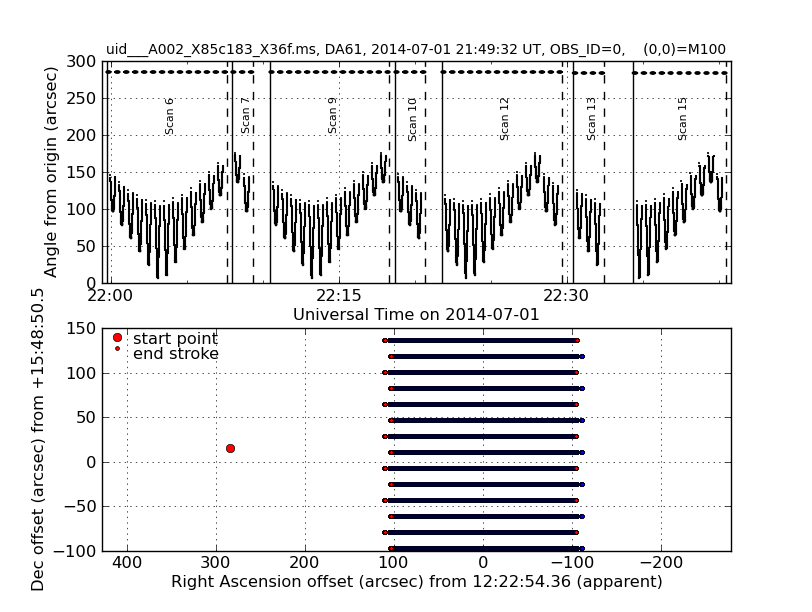
</figure>
# In CASA
aU.getTPSampling(vis='uid___A002_X85c183_X36f.ms',
showplot=True,
plotfile='uid___A002_X85c183_X36f.ms.sampling.png')
Convert MS into Single-Dish Data Format
In order to calibrate the data, we need the data to be in the single-dish scantable (ASAP) format. Most of the tasks that we will use for calibration are inherited from the ASAP package, which has been incorporated into CASA. The ASAP package uses a different data format, so from a global point of view, what we are going to do is, first convert the MS to the ASAP format, then run the necessary calibration tasks, then convert the data back to the MS format. An effort for transition from ASAP to MS is ongoing; in a future version of CASA this step will become unnecessary.
We use the task sdsave to do this (its option outform, to specify the format of the output data, is defaulted to 'ASAP'). At the same time, the output data are split by antennas, by using the option splitant=True.
# In CASA
sdsave(infile='uid___A002_X85c183_X36f.ms',
splitant=True,
outfile='uid___A002_X85c183_X36f.ms.asap',
overwrite=True)
In this case, three ASAP datasets (uid___A002_X85c183_X36f.ms.DA61.asap, uid___A002_X85c183_X36f.ms.PM03.asap, and uid___A002_X85c183_X36f.ms.PM04.asap) are generated. As usual, we will first obtain information about the content of the datasets, using the task sdlist (which plays the same role as listobs).
# In CASA
for ant in ['DA61', 'PM03', 'PM04']:
sdlist(infile='uid___A002_X85c183_X36f.ms.%s.asap' % ant,
outfile='uid___A002_X85c183_X36f.ms.%s.asap.sdlist' % ant)
Here is an example of the output for uid___A002_X85c183_X36f.ms.DA61.asap. The displayed information is in principle the same as what you got from listobs (except for reduced number of antennas), although sdlist uses different expression (inherited from ASAP) from that of listobs (CASA native) -- e.g., "ScanIntent" in listobs is shown as "SrcType" in sdlist (CALIBRATE_something to CALON, ON_SOURCE to PSON, OFF_SOURCE to PSOFF, etc.).
# In CASA
os.system('cat uid___A002_X85c183_X36f.ms.DA61.asap.sdlist')
--------------------------------------------------------------------------------
Scan Table Summary
--------------------------------------------------------------------------------
Project: uid://A002/X82e287/X3
Obs Date: 2014/07/01/21:49:32
Observer: cvlahakis
Antenna Name: ALMA//DA61@A075
Data Records: 41726 rows
Obs. Type: CALIBRATE_POINTING#ON_SOURCE,CALIBRATE_WVR#ON_SOURCE
Beams: 1
IFs: 25
Polarisations: 2 (linear)
Channels: 4080
Flux Unit: K
Abscissa: Channel
Selection: none
Scan Source Time range Int[s] Record SrcType FreqIDs MolIDs
Beam Position (J2000)
--------------------------------------------------------------------------------
1 J1215+1654 2014/07/01/21:51:26.28 - 21:53:29.48 1.01574 2029 [PSON:CALON] [0, 1, 2, 3, 4, 5, 6, 7, 8] [0]
0 J2000 12:15:03.989 +16.54.37.559
2 J1215+1654 2014/07/01/21:55:24.90 - 21:56:25.45 0.49753 2070 [PSON:CALON, PSOFF:CALON] [0, 9, 10, 11, 12, 13, 14, 15, 16] [0]
0 J2000 12:15:03.988 +16.54.37.560
3 J1215+1654 2014/07/01/21:56:27.21 - 21:56:53.05 0.500364 594 [PSOFF:CALON, PSON:CALON] [0, 9, 10, 11, 12, 13, 14, 15, 16] [0]
0 J2000 12:15:03.988 +16.54.37.561
4 J1215+1654 2014/07/01/21:56:56.52 - 21:57:17.88 1.76957 194 [PSON:CALON] [0, 17, 18, 19, 20, 21, 22, 23, 24] [0, 1, 2, 3, 4]
0 J2000 12:15:03.988 +16.54.37.560
5 M100 2014/07/01/21:58:22.41 - 21:58:47.39 0.500364 594 [PSOFF:CALON, PSON:CALON] [0, 9, 10, 11, 12, 13, 14, 15, 16] [0]
0 J2000 12:23:13.286 +15.48.50.161
6 M100 2014/07/01/21:59:41.64 - 22:07:36.12 1.01591 7720 [PSOFF, PSON] [0, 17, 18, 19, 20, 21, 22, 23, 24] [0, 1, 2, 3, 4]
0 J2000 12:23:13.286 +15.48.50.162
7 M100 2014/07/01/22:07:54.69 - 22:09:19.80 1.01608 1390 [PSOFF, PSON] [0, 17, 18, 19, 20, 21, 22, 23, 24] [0, 1, 2, 3, 4]
0 J2000 12:23:13.285 +15.48.50.164
8 M100 2014/07/01/22:09:38.49 - 22:10:03.47 0.500364 594 [PSOFF:CALON, PSON:CALON] [0, 9, 10, 11, 12, 13, 14, 15, 16] [0]
0 J2000 12:23:13.285 +15.48.50.165
9 M100 2014/07/01/22:10:25.58 - 22:18:18.96 1.01586 7717 [PSOFF, PSON] [0, 17, 18, 19, 20, 21, 22, 23, 24] [0, 1, 2, 3, 4]
0 J2000 12:23:13.285 +15.48.50.165
10 M100 2014/07/01/22:18:38.66 - 22:20:39.48 1.01599 1965 [PSOFF, PSON] [0, 17, 18, 19, 20, 21, 22, 23, 24] [0, 1, 2, 3, 4]
0 J2000 12:23:13.285 +15.48.50.168
11 M100 2014/07/01/22:20:57.16 - 22:21:23.00 0.500364 594 [PSOFF:CALON, PSON:CALON] [0, 9, 10, 11, 12, 13, 14, 15, 16] [0]
0 J2000 12:23:13.285 +15.48.50.174
12 M100 2014/07/01/22:21:44.13 - 22:29:38.62 1.01584 7716 [PSOFF, PSON] [0, 17, 18, 19, 20, 21, 22, 23, 24] [0, 1, 2, 3, 4]
0 J2000 12:23:13.285 +15.48.50.169
13 M100 2014/07/01/22:30:23.68 - 22:32:24.51 1.01599 1965 [PSOFF, PSON] [0, 17, 18, 19, 20, 21, 22, 23, 24] [0, 1, 2, 3, 4]
0 J2000 12:23:13.284 +15.48.50.173
14 M100 2014/07/01/22:33:29.37 - 22:33:54.35 0.500364 594 [PSOFF:CALON, PSON:CALON] [0, 9, 10, 11, 12, 13, 14, 15, 16] [0]
0 J2000 12:23:13.284 +15.48.50.175
15 M100 2014/07/01/22:34:19.84 - 22:40:28.35 1.01584 5990 [PSOFF, PSON] [0, 17, 18, 19, 20, 21, 22, 23, 24] [0, 1, 2, 3, 4]
0 J2000 12:23:13.284 +15.48.50.179
--------------------------------------------------------------------------------
FREQUENCIES: 9
ID IFNO(SPW) #Chans Frame Ch0[MHz] ChanWid[kHz] Center[MHz] POLNOs
0 0 4 TOPO 183925 2500000 187675 [0]
1 1 124 TOPO 91955.5125 -15625 90994.575 [0, 1]
2 2 1 TOPO 90978.95 -1734375 90978.95 [0, 1]
3 3 124 TOPO 93893.0125 -15625 92932.075 [0, 1]
4 4 1 TOPO 92924.2625 -1937500 92924.2625 [0, 1]
5 5 124 TOPO 102033.637 15625 102994.575 [0, 1]
6 6 1 TOPO 102986.762 1937500 102986.762 [0, 1]
7 7 124 TOPO 104033.637 15625 104994.575 [0, 1]
8 8 1 TOPO 104986.762 1937500 104986.762 [0, 1]
9 9 128 TOPO 101942.187 -15625 100950 [0, 1]
10 10 1 TOPO 100926.562 -1781250 100926.562 [0, 1]
11 11 128 TOPO 103757.337 -15625 102765.15 [0, 1]
12 12 1 TOPO 102741.712 -1781250 102741.712 [0, 1]
13 13 128 TOPO 111814.962 15625 112807.15 [0, 1]
14 14 1 TOPO 112783.712 1781250 112783.712 [0, 1]
15 15 128 TOPO 113689.962 15625 114682.15 [0, 1]
16 16 1 TOPO 114658.712 1781250 114658.712 [0, 1]
17 17 4080 TOPO 101945.85 -488.28125 100950 [0, 1]
18 18 1 TOPO 100949.756 -1992187.5 100949.756 [0, 1]
19 19 4080 TOPO 103761 -488.28125 102765.15 [0, 1]
20 20 1 TOPO 102764.906 -1992187.5 102764.906 [0, 1]
21 21 4080 TOPO 111811.3 488.28125 112807.15 [0, 1]
22 22 1 TOPO 112806.906 1992187.5 112806.906 [0, 1]
23 23 4080 TOPO 113686.3 488.28125 114682.15 [0, 1]
24 24 1 TOPO 114681.906 1992187.5 114681.906 [0, 1]
--------------------------------------------------------------------------------
MOLECULES:
ID RestFreq Name
0 [] []
1 [1.0095e+11] [Manual_window(ID=0)]
2 [1.027941e+11] [Manual_window(ID=0)]
3 [1.127941e+11] [Manual_window(ID=0)]
4 [1.146691e+11] [CO_v_0_1_0(ID=3768098)]
--------------------------------------------------------------------------------
Inspect the System Noise Temperature
Let's start by checking the Tsys. We use the task gencal to extract the Tsys into a CASA calibration table.
# In CASA
gencal(vis='uid___A002_X85c183_X36f.ms',
caltable='uid___A002_X85c183_X36f.ms.tsys',
caltype='tsys')
The generated Tsys calibration table can be plotted using the task plotbandpass and the checkCalTable function of the Analysis Utilities. The generated plots are saved in the directories uid___A002_X85c183_X36f.ms.tsys.plots.overlayTime and uid___A002_X85c183_X36f.ms.tsys.plots.
<figure id="X36f.Tsys.overlayTime.png">
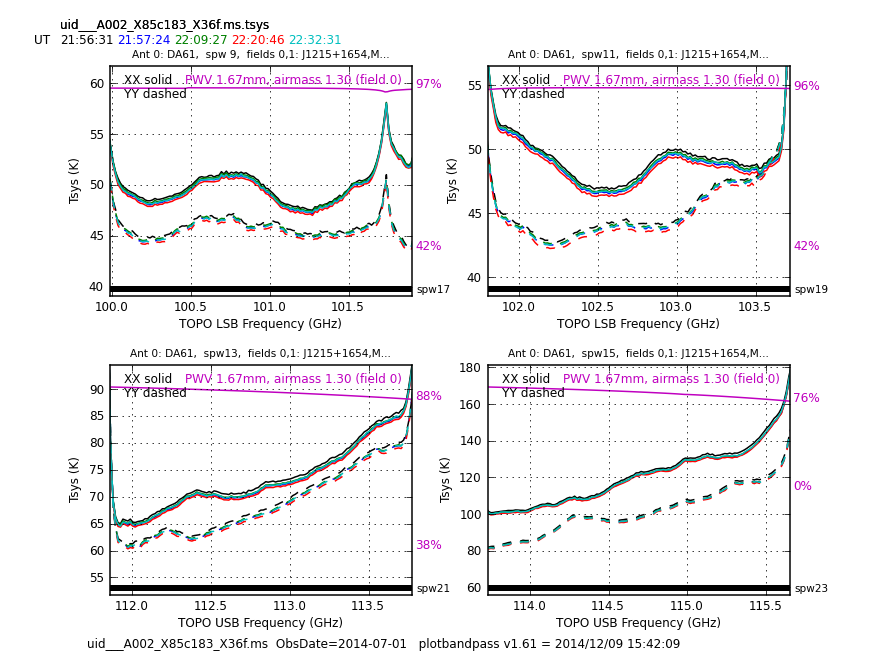
</figure>
<figure id="X36f.Tsys.overlayAntenna.png.png">
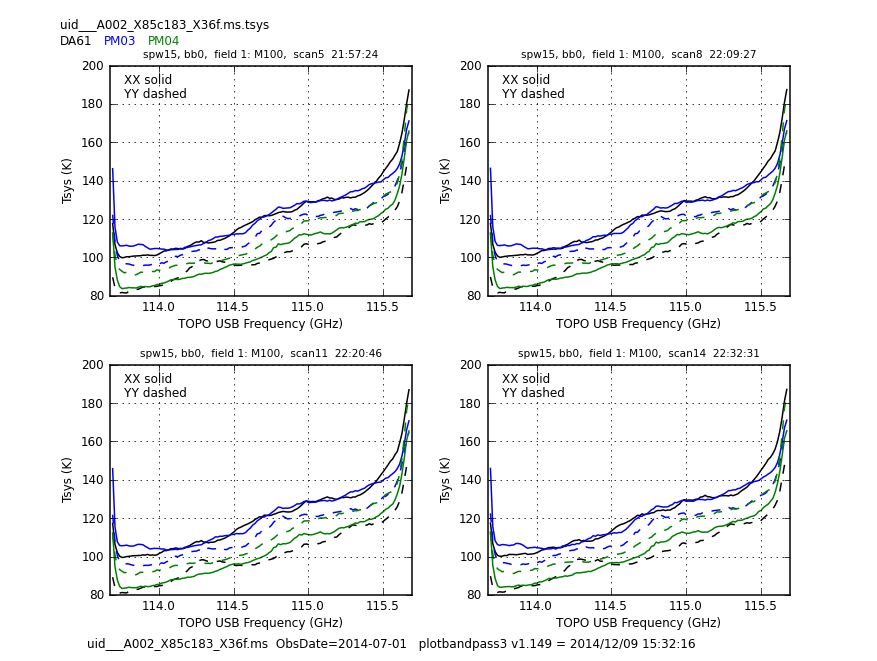
</figure>
# In CASA
plotbandpass(caltable='uid___A002_X85c183_X36f.ms.tsys',
overlay='time',
xaxis='freq',
yaxis='amp',
subplot=22,
buildpdf=False,
interactive=False,
showatm=True,
pwv='auto',
chanrange='5~123',
showfdm=True,
field='',
figfile='uid___A002_X85c183_X36f.ms.tsys.plots.overlayTime/uid___A002_X85c183_X36f.ms.tsys')
es.checkCalTable('uid___A002_X85c183_X36f.ms.tsys',
msName='uid___A002_X85c183_X36f.ms',
interactive=False)
A Priori Flagging
Now we do some a-priori flagging of the edge channels. Although the "science" SPW's have 1992 MHz bandwidths with 4080 spectral channels, their edge channels are very noisy, because each intermediate frequency signal path (baseband) is equipped with a bandpass filter of ~1.8 GHz width. We flag 120 channels on each side of the "science" SPW's. As a result 3840 channels (1875 MHz bandwidth), i.e., the same number of channels and bandwidth as FDM SPW's in the 12-m array data, remain in each SPW.
# In CASA
for ant in ['DA61', 'PM03', 'PM04']:
sdflag(infile='uid___A002_X85c183_X36f.ms.%s.asap' % ant,
mode='manual',
spw='17:0~119;3960~4079,19:0~119;3960~4079,21:0~119;3960~4079,23:0~119;3960~4079',
overwrite = True)
Tsys Calibration
We calibrate the data into brightness temperature in units of K, using the equation Ta* = Tsys*(ON-OFF)/OFF, where ON and OFF are the data on-source (i.e., during the raster scanning) and off-source (on an emission-free reference position), respectively. The calibration is done by the task Template:Sdcal2. It requires the list of the "science" SPW's and Tsys SPW's, and the correspondence between them. We can tell from the listobs (or sdlist) output that Tsys SPW's 9, 11, 13, and 15 correspond to "science" SPW's 17, 19, 21, and 23, respectively; but the function tsysspwmap helps to map Tsys SPW's to science SPW's in an automated way:
# In CASA
from recipes.almahelpers import tsysspwmap
tsysmap = tsysspwmap(vis='uid___A002_X85c183_X36f.ms',
tsystable='uid___A002_X85c183_X36f.ms.tsys')
spwmap = {}
for i in [17, 19, 21, 23]:
if not tsysmap[i] in spwmap.keys():
spwmap[tsysmap[i]] = []
spwmap[tsysmap[i]].append(i)
The obtained correspondence between Tsys and science SPW's (stored in the variable spwmap) is given to sdcal2, along with the comma-separated lists of SPW's. An important parameter of the task is calmode. In case of the science dataset uid___A002_X85c183_X895, calmode should be set to 'ps,tsys,apply'. 'ps' means that the data at dedicated reference position are used as "OFF" for the OFF subtraction, (ON-OFF)/OFF. 'tsys' is to calibrate the data using Tsys. 'apply' is to apply the both calibrations above (OFF-subtraction and Tsys).
# In CASA
for ant in ['DA61', 'PM03', 'PM04']:
sdcal2(infile='uid___A002_X85c183_X36f.ms.%s.asap' % ant,
calmode='ps,tsys,apply',
spw='9,11,13,15,17,19,21,23',
tsysspw='9,11,13,15',
spwmap=spwmap,
outfile='uid___A002_X85c183_X36f.ms.%s.asap.cal' % ant,
overwrite=True)
A new ASAP dataset with additional suffix '.cal' is generated for each antenna. Before proceeding to the next step, we can plot the calibrated spectra using the SDcheckSpectra function of the Analysis Utilities. PNG files will be created in, e.g., uid___A002_X85c183_X36f.ms.DA61.asap.cal.plots directory. You will find the CO line in SPW 23 of the science datasets.
<figure id="X36f.spw23.cal.png">
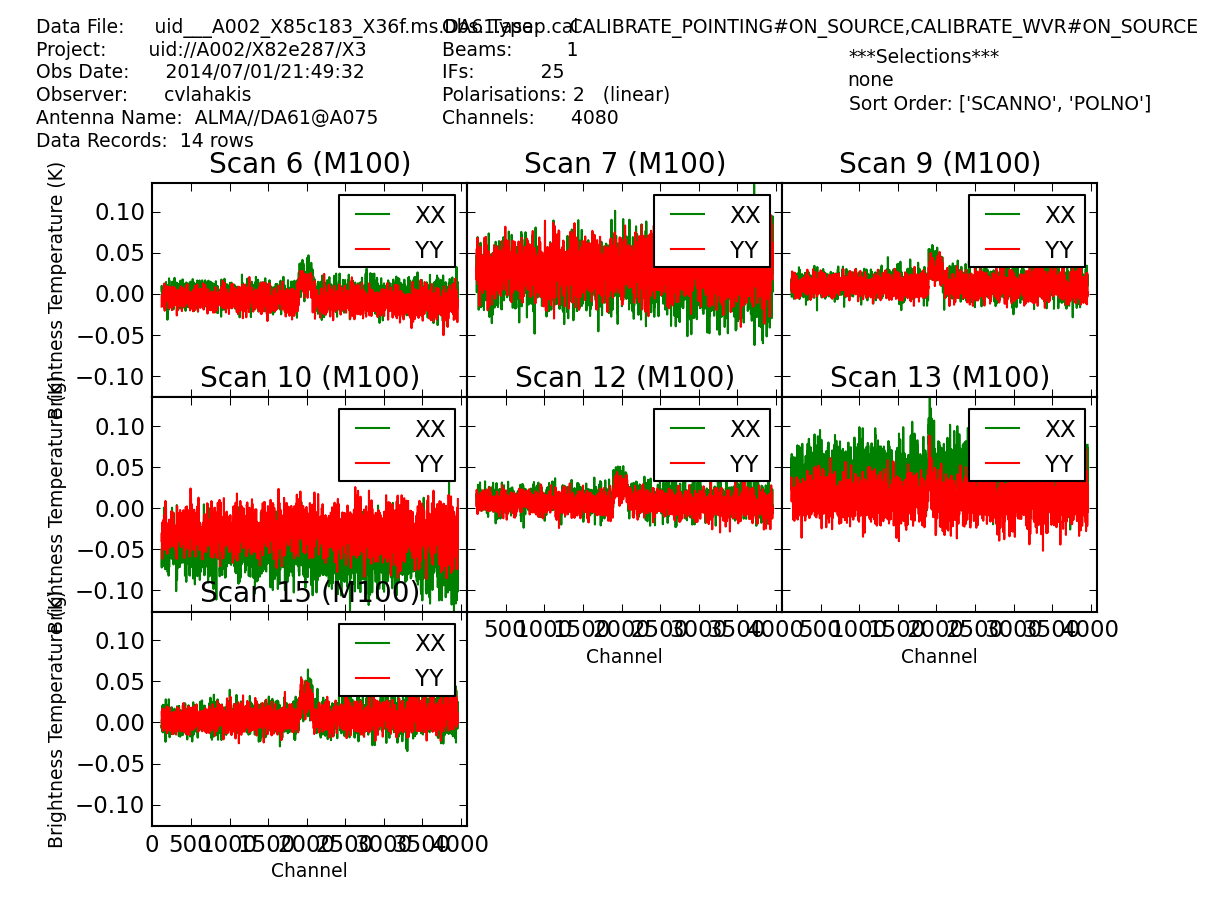
</figure>
# In CASA
for ant in ['DA61', 'PM03', 'PM04']:
es.SDcheckSpectra('uid___A002_X85c183_X36f.ms.%s.asap.cal' % ant,
spwIds='17,19,21,23',
interactive=False)
For amplitude calibrator datasets, on the other hand, calmode option for sdcal2 should be 'otfraster,tsys,apply' ('otfraster' instead of 'ps'). 'otfraster' tells the task to use the both ends of each raster row as "OFF" data. This is because temporal fluctuation of atmospheric emission is the dominant source of noise in radio continuum observations, and hence OFF needs to be as close as possible to ON.
Application of Non-Linearity Correction Factor
In the period of Early Science Cycle 1/2, single-dish data taken with the ACA correlator suffer from non-linearity which originates in the digital signal processing. Its impact was thoroughly studied both experimentally and theoretically, and it was concluded that multiplying the correction factor of 1.25 yields the amplitude accuracy of +/-5%. This is done by the task sdscale. A new ASAP dataset with additional suffix '.nlc' (for Non-Linearity Correction) will be created for each antenna.
# In CASA
for ant in ['DA61', 'PM03', 'PM04']:
sdscale(infile='uid___A002_X85c183_X36f.ms.%s.asap.cal' % ant,
outfile='uid___A002_X85c183_X36f.ms.%s.asap.cal.nlc' % ant,
factor=1.25)
Upgradng the ACA correlator hardware and software, which is planned in February 2015, is expected to solve the non-linearity issue. Thus this step will become unnecessary in the near future.
Baseline Subtraction (only for Science Datasets)
We will now subtract spectral baselines. This is done with the task sdbaseline. With the option "maskmode='auto'", the task automatically finds line features from individual spectra and exclude them from baseline fitting. A caveat is that is that the line finding may not work very well in some, including this, cases. See "Subtract a Residual Background from the Image" section below.
# In CASA
for ant in ['DA61', 'PM03', 'PM04']:
sdbaseline(infile='uid___A002_X85c183_X36f.ms.%s.asap.cal.nlc' % ant,
spw='17,19,21,23',
maskmode='auto',
thresh=5.0,
avg_limit=4,
blfunc='poly',
order=1,
outfile='uid___A002_X85c183_X36f.ms.%s.asap.cal.nlc.bl' % ant,
overwrite=True)
Datasets with yet another suffix ".bl" are generated. The spectra can be checked using SDcheckSpectra which we have already used in a previous step.
<figure id="X36f.spw23.cal.bl.png">
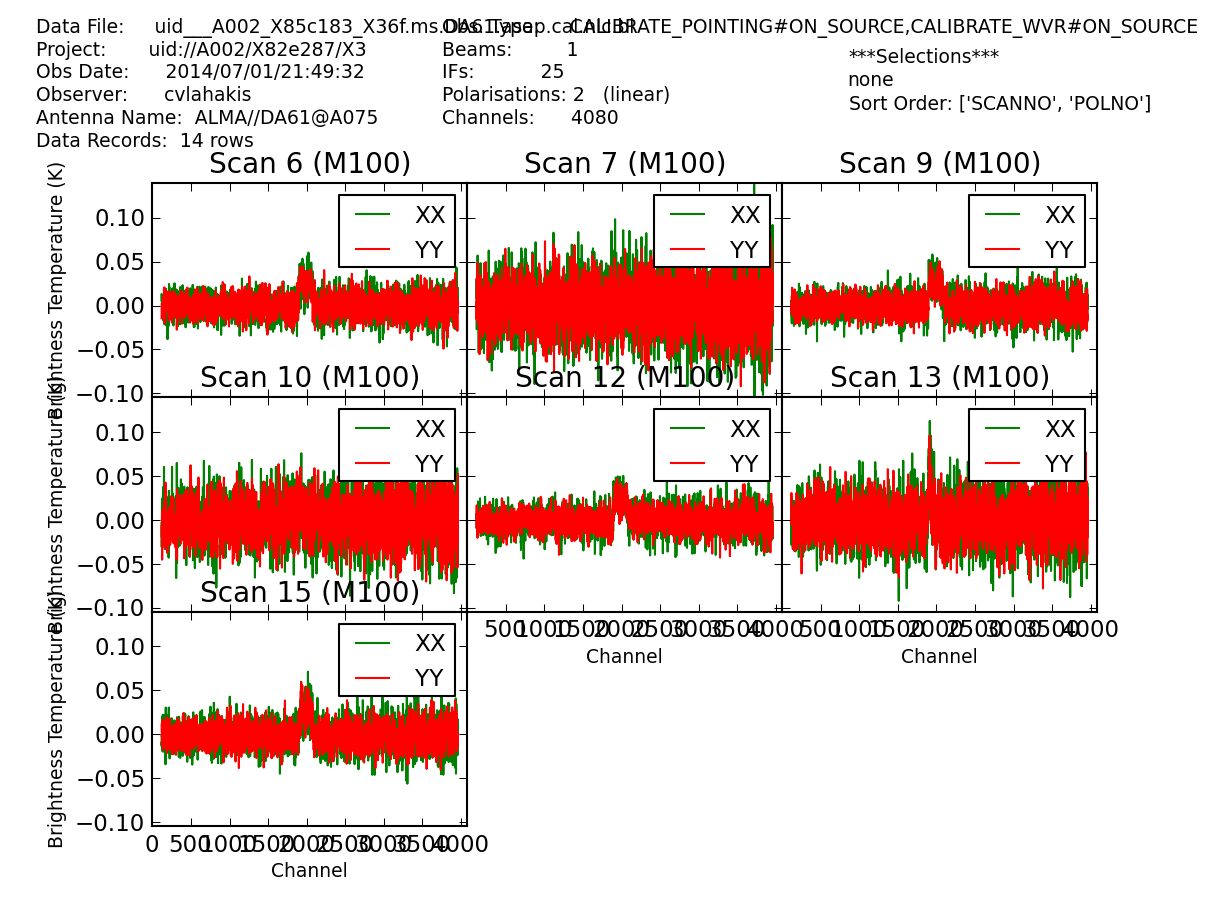
</figure>
# In CASA
for ant in ['DA61', 'PM03', 'PM04']:
es.SDcheckSpectra('uid___A002_X85c183_X36f.ms.%s.asap.cal.nlc.bl' % ant,
spwIds='17,19,21,23',
interactive=False)
Note that baseline subtraction should not be done for the amplitude calibrator datasets -- it will eliminate the continuum emission!
Convert Single-Dish Data back to MS
Now the calibrated data need to be coverted back to MS, because the imaging task (sdimaging) only accepts MS. The CASA task sdsave will do this.
# In CASA
for ant in ['DA61', 'PM03', 'PM04']:
sdsave(infile='uid___A002_X85c183_X36f.ms.%s.asap.cal.nlc' % ant,
outfile='uid___A002_X85c183_X36f.ms.%s.asap.cal.nlc.ms' % ant,
outform='MS2')
And concatenate the data which were split by antennas, using the task concat.
# In CASA
concat(vis=['uid___A002_X85c183_X36f.ms.DA61.asap.cal.nlc.ms',
'uid___A002_X85c183_X36f.ms.PM03.asap.cal.nlc.ms',
'uid___A002_X85c183_X36f.ms.PM04.asap.cal.nlc.ms'],
concatvis='uid___A002_X85c183_X36f.ms.cal')
We do not concatenate separate Execution Blocks, because we need to determine and apply day-by-day Jy/K conversion factor.
Note that one of the antennas, PM02, had a problem in the first baseband (SPW 17) on 2014-07-05, and its impact may not be specific to one SPW -- i.e., it may have resulted in poor pointing calibration. Therefore the PM02 data should be excluded from the concatenation. The affected datasets were uid___A002_X8602fa_Xc3 (amplitude calibrator), uid___A002_X8602fa_X2ab (science), and uid___A002_X8602fa_X577 (science).
Image the Amplitude Calibrator and Measure the Value of Jy/K
Now that all the datasets have been calibrated into units of Kelvins, the next step is to determine the Jy/K conversion factors from the amplitude calibrator datasets. This is done by imaging a source whose continuum flux is known, and measure the observed brightness temperature. The script "scriptForImagingAmpCalAndDerivingJyPerK.py" is used for this step. The procedure to derive the Jy/K value for a single dataset (uid___A002_X85c183_X895) and single SPW (23) is described in this guide, whereas all four datasets and four SPW's are processed using for-loops in the script.
Firstly set variables for the name of a calibrated dataset and a couple of parameters to predict the expected beam size. The beam size is used to determine the appropriate grid spacing and gridding convolution function to image the source.
# In CASA
msname = 'uid___A002_X85c183_X895.ms.cal'
fwhmfactor = 1.13
diameter = 12
Open a file in which the derived Jy/K values will be written.
# In CASA
fout = open(msname+'.JyPerK.txt', 'w')
Obtain the spatial sampling of the data (spacings along and perpendicular to the scan direction, and the largest dimension in arcsec) using the function getTPSampling of the Analysis Utilities.
# In CASA
xSampling, ySampling, maxsize = aU.getTPSampling(msname, showplot=False)
Obtain the list of antennas.
# In CASA
msmd.open(msname)
antlist = msmd.antennanames()
msmd.close()
Specify an SPW for which the Jy/K value is derived. The center frequency of the SPW is obtained, and then the expected beam size is calculated using the function primaryBeamArcsec of the Analysis Utilities.
# In CASA
spw = 23
msmd.open(msname)
freq = msmd.meanfreq(spw)
msmd.close()
theorybeam = aU.primaryBeamArcsec(frequency=freq*1e-9,
fwhmfactor=fwhmfactor,
diameter=diameter)
The cell spacing and size of the map are determined from the beam size and the dimension of the raster map.
# In CASA
cell = theorybeam/9.0
imsize = int(round(maxsize/cell)*2)
Obtain the ID and name of the field.
# In CASA
msmd.open(msname)
fieldid = msmd.fieldsforspw(spw, False)[0]
fieldname = msmd.fieldsforspw(spw, True)[0]
msmd.close()
phasecenter = fieldid
Now the image of the source is made for each antenna using the task sdimaging. The gridding convolution function used is 'SF' (prolate spheroidal wave function) with the support of 6 cell spacings, where the cell spacing is 1/9 of the beam size. These parameters are chosen according to the NAASC Memo 114 (draft).
# In CASA
for ant in antlist:
sdimaging(infiles=msname,
field=str(fieldname),
spw='%d' % spw,
antenna=ant,
nchan=1,
mode='channel',
width='4080',
gridfunction='SF',
convsupport= 6,
phasecenter=phasecenter,
ephemsrcname='',
imsize=imsize,
cell=str(cell)+'arcsec',
overwrite=True,
outfile='%s.%s.spw%d.image' % (msname, ant, spw))
The continuum flux of the source is obtained from the ALMA source catalog using the function getALMAFluxForMS of the Analysis Utilities.
# In CASA
srcflux = aU.getALMAFluxForMS(msname,
field=fieldname,
spw=str(spw))[fieldname]['fluxDensity']
Finally derive the Jy/K values by comparing the flux of the source (in Jy) with the observed brightness temperature (in K). In the case of this guide the amplitude calibrator is a point source (quasar 3C279), and hence the Jy/K value is simply estimated by the ratio between the source flux obtained above and the peak brightness temperature determined using the task imstat. Note that if the amplitude calibrator is a planet, the correction for the source size (multiplying the ratio between the areas of planet-deconvolved beam and apparent beam) is necessary. This process is not written in the code presented here, but implemented in the script "scriptForImagingAmpCalAndDerivingJyPerK.py".
# In CASA
jyperklist = []
for ant in antlist:
peak = imstat('%s.%s.spw%d.image' % (msname, ant, spw))['max'][0]
fwhm = aU.getfwhm2('%s.%s.spw%d.image' % (msname, ant, spw))
jyperk = srcflux/peak
print 'SPW%d %s Jy/K = %.2f' % (spw, ant, jyperk)
fout.write('%d\t%s\t%.2f\n' % (spw, ant, jyperk))
jyperklist.append(jyperk)
print '### SPW%d mean Jy/K = %.2f ###' % (spw, pl.mean(jyperklist))
fout.write('%d\t%s\t%.2f\n' % (spw, 'mean', pl.mean(jyperklist)))
Finally close the file in which the Jy/K values were written.
# In CASA
fout.close()
The resultant Jy/K values are the followings. Note that the values for individual antennas are averaged for each day, each SPW.
#Date Amp_Cal_Dataset SPW17 SPW19 SPW21 SPW23 2014-07-01 uid___A002_X85c183_X895 41.37 42.39 43.45 42.82 2014-07-05 uid___A002_X8602fa_Xc3 40.99 42.74 40.08 42.09 2014-07-07 uid___A002_X864236_Xe1 39.42 42.08 40.18 40.82 2014-07-17 uid___A002_X86fcfa_X3ae 43.49 43.70 42.01 43.04
Convert the Science Target Units from Kelvin to Jansky
The science data, that have been calibrated into brightness temperature in units of K, are now converted into Jy units by multiplying the Jy/K factors derived above. This step is done by the script "scriptForJyPerKConversion.py".
Define the lists of SPWs and corresponding Jy/K factors in order to process the data using for-loops.
# In CASA
# List the science spws
spwlist = [17, 19, 21, 23]
# List the Jy/K values (corresponding to the list of the science spws above)
# that were the output from scriptForImagingAmpCalAndDerivingJyPerK.py
jyperklist0701 = [41.37, 42.39, 43.45, 42.82]
jyperklist0705 = [40.99, 42.74, 40.08, 42.09]
jyperklist0707 = [39.42, 42.08, 40.18, 40.82]
jyperklist0717 = [43.49, 43.70, 42.01, 43.04]
Make a copy of calibrated dataset, with an additional suffix ".jy", and multiply the Jy/K value for each SPW. This is done by the scaleAutocorr function of Analysis Utilities.
# In CASA
# Data taken on 2014-07-01
for name in ['uid___A002_X85c183_X36f', 'uid___A002_X85c183_X60b']:
os.system('rm -Rf %s.ms.cal.jy' % name)
os.system('cp -Rf %s.ms.cal %s.ms.cal.jy' % (name, name))
for (spw, jyperk) in zip(spwlist, jyperklist0701):
aU.scaleAutocorr(vis='%s.ms.cal.jy' % name, scale=jyperk, spw=spw)
# Data taken on 2014-07-05
for name in ['uid___A002_X8602fa_X2ab', 'uid___A002_X8602fa_X577']:
os.system('rm -Rf %s.ms.cal.jy' % name)
os.system('cp -Rf %s.ms.cal %s.ms.cal.jy' % (name, name))
for (spw, jyperk) in zip(spwlist, jyperklist0705):
aU.scaleAutocorr(vis='%s.ms.cal.jy' % name, scale=jyperk, spw=spw)
# Data taken on 2014-07-07
for name in ['uid___A002_X864236_X2d4', 'uid___A002_X864236_X693']:
os.system('rm -Rf %s.ms.cal.jy' % name)
os.system('cp -Rf %s.ms.cal %s.ms.cal.jy' % (name, name))
for (spw, jyperk) in zip(spwlist, jyperklist0707):
aU.scaleAutocorr(vis='%s.ms.cal.jy' % name, scale=jyperk, spw=spw)
# Data taken on 2014-07-17
for name in ['uid___A002_X86fcfa_Xd9', 'uid___A002_X86fcfa_X664',
'uid___A002_X86fcfa_X96c']:
os.system('rm -Rf %s.ms.cal.jy' % name)
os.system('cp -Rf %s.ms.cal %s.ms.cal.jy' % (name, name))
for (spw, jyperk) in zip(spwlist, jyperklist0717):
aU.scaleAutocorr(vis='%s.ms.cal.jy' % name, scale=jyperk, spw=spw)
Image the Science Target
Now all the science datasets have been calibrated into Jy units. The next (final) step is to image the science data. This step is done by the script "scriptForImagingScienceTarget.py".
Define the list of the calibrated science datasets, which the CASA task sdimaging accepts.
# In CASA
sciencedata = [('%s.ms.cal.jy' % name) for name in basename_science]
Obtain the data sampling and determine the cell spacing and map size based on the mean frequency of the target SPW. This part is in principle the same as the corresponding procedure in the "Image the Amplitude Calibrator and Measure the Value of Jy/K" section.
# In CASA
fwhmfactor = 1.13
diameter = 12
xSampling, ySampling, maxsize = aU.getTPSampling(sciencedata[0], showplot=False)
spw = 23
msmd.open(sciencedata[0])
freq = msmd.meanfreq(spw)
msmd.close()
print "SPW %d: %.3f GHz" % (spw, freq*1e-9)
theorybeam = aU.primaryBeamArcsec(frequency=freq*1e-9,
fwhmfactor=fwhmfactor,
diameter=diameter)
cell = theorybeam/9.0
imsize = int(round(maxsize/cell)*2)
Now the data are imaged. The velocity channel maps of the CO J=1-0 line (restfreq='115.271204GHz') are created as a data cube which covers the velocity range of 1400-1700 km/s at a spacing of 5 km/s (start='1400km/s', width='5km/s', nchan=70).
Note that the Jy/K value depends on the parameters of gridding convolution (i.e., "gridfunction", "cell", and function-specific parameters ["convsupport" for gridfunction='SF']). That is, the same gridding parameters should be used for both amplitude calibrator and science images -- otherwise the calibration into Jy unit becomes invalid.
# In CASA
sdimaging(infiles=sciencedata,
field='M100',
spw='%d' % spw, #sciencespw
nchan=70,
mode='velocity',
start='1400km/s',
width='5km/s',
veltype='radio',
outframe='lsrk',
restfreq='115.271204GHz',
gridfunction='SF',
convsupport=6,
stokes='',
phasecenter='J2000 12h22m54.9 +15d49m15',
ephemsrcname='',
imsize=imsize,
cell=str(cell)+'arcsec',
overwrite=True,
outfile='M100.CO.cube.image')
The produced image has the brightness unit of K in the image header, which is not correct. Modify the header using the task imhead.
# In CASA
imhead(imagename='M100.CO.cube.image',
mode='put',
hdkey='bunit',
hdvalue='Jy/beam')
(Optionally) Subtract a Residual Background from the Image
Now you can browse the data cube using the viewer.
# In CASA
viewer('M100.CO.cube.image')
If you plot the line profile using the viewer, you may notice that the background (i.e., emission-free channels) level is slightly negative. In order to correct this, spectral baselines are subtracted from the image using the task imcontsub.
# In CASA
imcontsub(imagename='M100.CO.cube.image',
linefile='M100.CO.cube.bl.image',
contfile='M100.ignorethis.image',
fitorder=1,
chans='0~7;62~69')
os.system('rm -rf M100.ignorethis.image')
The main cause of the negative baseline is the following. The task sdbaseline with maskmode='auto' is supposed to find lines from the data and exclude the detected lines from baseline fitting. However, the CO line from M100 is not bright enough to be detected from individual spectra (1-s integration), and hence sdbaseline included the velocity ranges of the line into baseline fitting. The impact of this effect would be smaller if the line is brighter, or narrower w.r.t. the correlator bandwidth.
Apply the Restoring Beam to the Science Image
The image does not have the beam size, which is necessary for combining the image with interferometric data, in the header. The beam size (including the broadening due to gridding convolution and data sampling) is calculated using the function sfBeam of the Analysis Utilities, and then written into the header using the functions of the ia tool.
# In CASA
minor, major, fwhmsfBeam, sfBeam = aU.sfBeam(frequency=freq*1e-9,
pixelsize=cell,
convsupport=6,
img=None, #to use Gaussian theorybeam
stokes='both',
xSamplingArcsec=xSampling,
ySamplingArcsec=ySampling,
fwhmfactor=fwhmfactor,
diameter=diameter)
ia.open('M100.CO.cube.bl.image')
ia.setrestoringbeam(major=str(sfBeam)+'arcsec', minor=str(sfBeam)+'arcsec', pa='0deg')
ia.done()
Quick Look at the Results
Make a 0th moment (integrated intensity) map using the task immoments and browse it using the viewer.
<figure id="M100.CO.cube.bl.image.mom0.png">
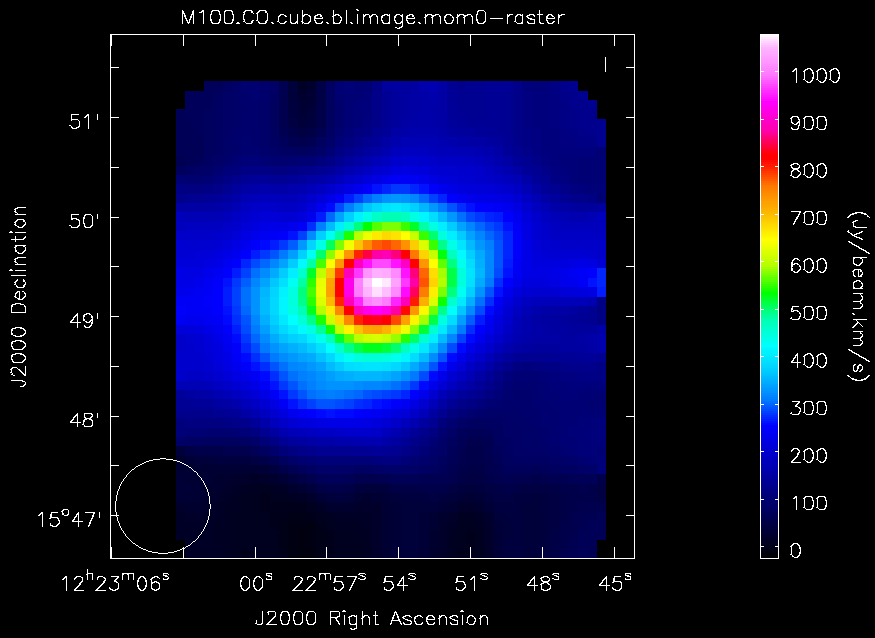
</figure>
# In CASA
os.system('rm -rf *M100.CO.cube.bl.image.mom0')
immoments(imagename='M100.CO.cube.bl.image',
moments=[0],
axis='spectral',
chans='8~61',
outfile='M100.CO.cube.bl.image.mom0')
viewer('M100.CO.cube.bl.image.mom0')